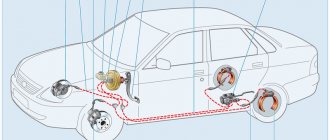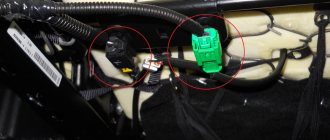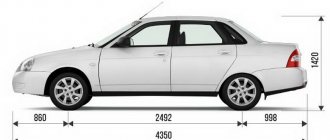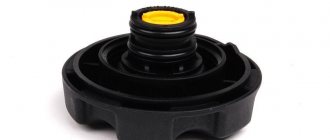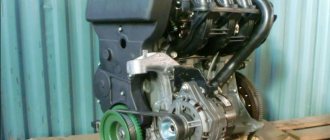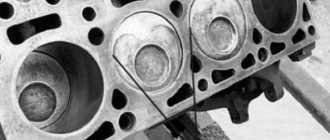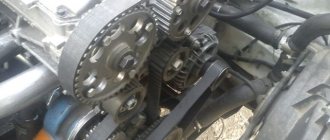The 1.6-liter 16-valve VAZ 21126 engine appeared in 2007 along with the Lada Priora and then spread to almost the entire model range of the Russian company AvtoVAZ. This unit was also often used as a blank for the concern’s sports engines.
The VAZ 16V line also includes: 11194, 21124, 21127, 21129, 21128 and 21179.
- Characteristics
- Description
- Consumption
- Application
- Reviews
- Service
- Breakdowns
- Prices
Technical characteristics of the VAZ 21126 1.6 16kl engine
| Type | in-line |
| Number of cylinders | 4 |
| Number of valves | 16 |
| Exact volume | 1597 cm³ |
| Cylinder diameter | 82 mm |
| Piston stroke | 75.6 mm |
| Supply system | injector |
| Power | 98 hp |
| Torque | 145 Nm |
| Compression ratio | 10.5 — 11 |
| Fuel type | AI-92 |
| Environmental standards | EURO 3/4 |
| Type | in-line |
| Number of cylinders | 4 |
| Number of valves | 16 |
| Exact volume | 1597 cm³ |
| Cylinder diameter | 82 mm |
| Piston stroke | 75.6 mm |
| Supply system | injector |
| Power | 114 - 118 hp |
| Torque | 150 - 154 Nm |
| Compression ratio | 11 |
| Fuel type | AI-92 |
| Environmental standards | EURO 4/5 |
| Type | in-line |
| Number of cylinders | 4 |
| Number of valves | 16 |
| Exact volume | 1597 cm³ |
| Cylinder diameter | 82 mm |
| Piston stroke | 75.6 mm |
| Supply system | injector |
| Power | 136 hp |
| Torque | 154 Nm |
| Compression ratio | 11 |
| Fuel type | AI-92 |
| Environmental standards | EURO 5 |
The online manual for this engine is here
The engine is briefly described in an article on ZaRulem
For such a unit there are also forged pistons
Design features of the Lada 21126 16 valve engine
The main difference between this internal combustion engine and its predecessors is the widespread use of foreign components in the assembly. First of all, this concerns a lightweight connecting rod and piston group manufactured by Federal Mogul, as well as a timing belt with an automatic tensioner from Gates.
Due to the strict requirements of the American company, the manufacturer of ShPG, additional procedures are carried out on the conveyor for processing the surfaces of the block, as well as honing the cylinders. There were also some disadvantages here: new pistons without holes made the power unit plug-in. Update: from mid-2022, the engines received an update in the form of plugless pistons.
Otherwise, everything is familiar here: a cast-iron block, which traces its history back to the VAZ 21083, a 16-valve aluminum head with two camshafts, standard for VAZ products, the presence of hydraulic compensators eliminates the need to adjust the valve clearances.
The video shows the consequences of a broken timing belt and subsequent head repair
The car engine 21126 is a four-stroke four-cylinder engine installed on a VAZ 2170 car. Fuel injection is distributed, the camshaft is located at the top. The VAZ 21126 engine is equipped with a liquid cooling system, closed type, coolant circulation is forced. The lubrication system is combined (spraying and under pressure).
To change gears, the Lada Priora is equipped with a five-speed gearbox.
The 126 engine has the following technical characteristics:
- Cylinders with a volume of 1.6 liters.
- The compression ratio is 11.
- Rated power is 98 horsepower.
- Priora engine 16 valves.
- Fuel is supplied by electronically controlled distributed injection.
- The sixteen valve engine weighs 115 kg.
Updates and shortcomings
The table clearly shows how many horses the Priora had with the old power plant and how the power and torque changed as the update progressed. Here is a description of how the design features of the new units changed compared to the old ones:
- The number of valves has increased, there are 4 of them for each cylinder. It's no secret what a positive impact this factor has on engine performance. The filling of the cylinder with the combustible mixture improves, the chamber is qualitatively emptied of combustion products (exhaust gases), the operation of the unit becomes more stable, power increases while fuel consumption decreases.
- The compression ratio is increased by increasing the piston stroke. The new engine 21126 and 21127 now uses gasoline with a higher octane number, but at the same time the efficiency of fuel combustion increases, which has a positive effect on power. It’s impossible not to notice how the working volume of the Priora’s engine has increased thanks to the increased piston stroke.
- In modification 21127, compared to 21126, the intake manifold was modified. How this affected the engine performance of the Priora can be seen in the table. Power increased by 8 hp. in addition, performance at low and medium speeds has improved.
- The new engines on the Priora have better environmental performance and lower fuel consumption. This was achieved through such improvements as modernizing the crankcase ventilation system and reducing the weight of the piston group. Now crankcase gases are burned more intensively in the cylinders and the emission of harmful substances into the atmosphere has decreased.
- Over the many years of operation of VAZ vehicles, a definite opinion has developed that the power units of Zhiguli cars do not last 150 thousand km until they are overhauled. Now, due to the use of new, higher quality components, the engine life has increased to at least 200 thousand km.
Despite the fact that the updated Priora engine is almost the most advanced domestic unit, it has its drawbacks. For example, when a timing belt breaks, the valves inevitably collide with the pistons and bend - this is its most serious drawback. How to eliminate it without waiting for trouble? It is necessary to replace the standard pistons with new ones, with special selections for the valves.
The remaining shortcomings are not so significant and they are usually associated with some kind of defect that can still be found on domestic cars. This could be increased noise from the operation of hydraulic compensators (often found on VAZ cars), an unexpectedly burnt gasket under the cylinder head, or floating idle speed. Or some unit of the attached equipment fails:
- a drop in fuel pressure in the system leads to difficulty starting the Priora engine and loss of its power;
- sensor malfunctions;
- air leaks in the fuel tract through the pipes;
- problems with the injector throttle valve.
Factors affecting the service life of the VAZ 2170
According to the manufacturer, the ICE 21126 with sixteen valves has a stable operation duration of 200 thousand kilometers. After a certain mileage it is necessary to carry out major repairs. Taking good care of the VAZ 2170, proper maintenance (MOT) and timely replacement of damaged components and parts will lead to a long service life of the vehicle.
Reasons affecting the service life of the power unit:
- Engine overheating. Elevated temperatures of a running engine negatively affect the overall service life of the motor. Maintaining the operating temperature of the power unit elements at a constant level significantly extends its operating time.
- Fuel. The vehicle's owner's manual contains detailed information about the recommended brand of gasoline. Filling the 16-valve Priora engine with fuel must be of proven quality.
- Machine oils. Which oil is best to fill, its brand and how much lubricant is needed is indicated in the accompanying documentation for the car. The 126 sixteen valve engine accepts semi-synthetic and synthetic motor oils most well. A complete oil change should be carried out annually or after a mileage of 15 thousand kilometers.
The optimal operating engine temperature is 90 - 95 °C. The rules allow the power unit to operate at temperatures reaching up to one hundred degrees, provided that the radiator fan is running. The engine temperature is considered low if it is below +90°C. In cold weather, it takes more time to warm up the engine to the desired mark on the device.
When servicing your VAZ 2107 car, the car owner can change the oil with his own hands. To do this, you need to know how to drain used lubricating fluid, what kind of oil to pour into the Priora and how much engine oil to pour into the neck.
Decoding the number on Lada Priora
Now that we have found out where the engine number is located on the Priora, let’s talk about its meaning. So:
- Name of the manufacturer.
- Number of compliance and confirmation of the vehicle according to all standards.
- Personal vehicle ID.
- Engine model version name.
- Maximum possible load on the front axle.
- Maximum possible load on the rear axle.
- Serial number of the package.
- Engine configuration version.
- Maximum load on the vehicle, including trailer (kg).
- Permissible vehicle weight.
- Serial number, which is used to order spare parts for a specific motor.
Thus. This contains the most important information about the vehicle, especially the individual values. It is worth special mentioning the model release, which has its own table.
The model year is the period that is equal to the average calendar year. Throughout it, cars are produced with the same characteristics that are characteristic of each other.
Are the valves bending?
In Lada Priora cars, even in a 16-valve 126 power unit, valves can often bend. The reasons causing this defect lie in non-compliance with operating rules, in case of violation of the regulations for replacing the following components and parts:
- rollers;
- timing belt;
- water pump.
If one of the listed components breaks down, the pistons, exerting mechanical stress on the valves, can bend them. The design features of the engine are the reasons why the engine can bend valves. Deformation of the valves necessitates a major overhaul of the Priora engine.
To avoid this defect, the car owner needs to timely check the timing elements. Of particular importance is the belt, which is subject to thorough inspection after 50 thousand kilometers. When checking, the following faults are excluded:
Why does oil accumulate in the spark plug wells in Priora and what does this lead to?
The problem is common in 1.6 liter engines. In early versions, there were rubber gaskets under the valve cover, while the updated ones use exclusively sealant to tightly fit the parts.
For a modern Priora, oil in the spark plug wells is formed as a result of the sealant drying out after long-term use of the car or when using a low-quality composition. Therefore, completely removing accumulated oil and old sealant will be the right solution to the problem.
This is the same case when the plant tried to reduce costs and simplify the design. However, they did not take into account one simple rule: “Kroilovo leads to Popadalovo.” This principle can be applied to all cases in life, and in relation to your car as well.
Oil can accumulate in the Priora well even in a completely new car, therefore, immediately after purchase it is worth checking the vehicle at a service station or in your own garage. Otherwise, a brand new car can present a very unpleasant surprise, and the reason for such a dirty trick lies solely in the sealant used.
Why does the engine stall?
Frequently encountered breakdowns of this power unit include such defects as unstable operation and engine tripping. Such failures occur due to malfunctions in engine components and parts:
- decrease in fuel pressure;
- defects in gas distribution mechanism elements;
- sensor malfunctions;
- violation of tightness in hoses;
- faulty throttle valve.
The power of the power unit is reduced for the following reasons:
- low compression in one or more cylinders;
- burnout of gaskets;
- wear of cylinder walls;
- erasing piston rings;
- deformation of pistons under the influence of high temperatures.
Engine friction can be eliminated by flushing the injectors. The reasons for unstable operation of the power unit may lie in the malfunction of the following devices:
- spark plugs for Priora 16 valves;
- ignition coil;
- throttle valve;
- idle air control;
- battery;
- starter;
- ignition coil;
- gasoline pump;
- fuel filter;
- fuel pressure regulating device.
You can replace the spark plugs on Priora yourself. To do this, you need to familiarize yourself with the principles of correct selection and replacement of these nodes, described in special articles on the Internet.
Diagnostic methods
When you find out that the motor is not working, you should diagnose it. This is the only way you can find out which cylinder failed and why. You can do this yourself, or go to a car service center. There the engine will be checked using a computer. However, most often you will be able to find out on your own why the engine is tripping. However, if there is a cylinder failure, and the reason is a decrease in compression, you should find a competent specialist who will solve your problem.
Priora engine tuning
To improve the power performance of the Priora power unit, they resort to the following modifications:
- The receiver is installed.
- Exhaust pattern: 4-2-1.
- Throttle valve: 54 -56 mm.
- Sports camshaft.
- Modification of the cylinder head (cylinder head) by sawing.
- Lightweight valves.
- 440cc type injectors.
In addition to the considered method of transforming the power unit to increase dynamic performance, there are several more ways to tune a car of this model.
Four-cylinder internal combustion engines of the 126 series are installed on Lada Priora cars and their modifications produced by the famous AvtoVAZ company. The 126 engine belongs to the category of four-stroke engines, is equipped with a distributed fuel injection system, the camshaft is located in the upper part. The power unit is equipped with a liquid cooling system. Coolant circulates inside a closed system under pressure. The functioning of the 21126 motor lubrication system is based on splashing and supplying fluid under pressure.
Engine Features 126
The development of the 21126 internal combustion engine was carried out in parallel with the VAZ-21124 internal combustion engine. With different working volumes of the models, a large number of coincidences were noted for the incoming systems and nodes. The main task before the creators of the 21126 engine was to obtain the most durable mechanism, characterized by a long service life.
The elements of the connecting rod and piston group were developed by Federal Mogul. The company's engineering team created a design that compares favorably in weight (30% lighter) with a similar kit installed on the 2110 machine.
In terms of external parameters, the engines of variants 124 and 126 are very similar, but there are certain differences between them. What is the difference between a 124 engine and a 126:
- The pistons of the 126 engine have less mass.
- The height of the block is 197.1 mm, while the diameter of the cylinders themselves has not changed.
- The inner walls of the cylinders are processed by honing using high technologies from Federal Mogul, which significantly improves their quality in comparison with analogues.
- The piston rings and pins are reduced in thickness, which also helps improve the power and speed characteristics of the motor (torque, efficiency, etc.).
- The cylinder block of the 126 engine is painted in a characteristic gray color, making it easy to distinguish from the 124 model.
In the Priora 126 engine, the ducts of the cylinder cooling jacket run along the entire height of the block. With this arrangement of channels, the degree of deformation of the body part is significantly reduced due to uneven exposure to ultra-high temperatures.
Important: Cars equipped with a 126 engine pick up speed faster. When tuning yourself, it is recommended to install brake system elements (pads, air-vented discs) that have the best quality and greatest efficiency.
Does engine 126 bend valves?
When choosing a new or used car, buyers often have a natural question whether the VAZ 126 engine bends the valve or not. All models equipped with internal combustion engines: Priora, VAZ 21126, 21116, 21127 suffer from a common drawback - when the timing belt breaks, the valves are deformed , and damage to the piston group also occurs.
Interesting: The VAZ 21124 engine is the only model that does not suffer from this problem. The 124th engine was installed on cars of the cheapest standard versions. In the modern version, the Priora 124 power unit has been replaced by the 116th model from Lada Granta.
Life situations
Often, stolen cars cannot be verified by the VIN of the body, which is broken up in settling tanks. Many car enthusiasts, when buying a vehicle secondhand, do not even suspect that the car has been stolen. To determine the authenticity of the body marking, you need to find the engine identifier. Today, according to statistics, Lada Priora is one of the most stolen vehicles for committing crimes.
As practice shows, after committing crimes, the vehicle is burned to remove fingerprints and identification data. And only by the engine number, which does not burn out, can you determine which car it is, as well as the owner. Many times, murderers and other criminals have been identified thanks to the surviving engine ID.
Also, it is worth noting that if a stolen vehicle ends up in an international database, then it is no longer possible to deregister it in another country.
This made life quite difficult for criminals. But in a number of CIS countries, such as Ukraine, cars have not been identified by engine markings for several years now.
Differences between engines 126 and 127 models
AvtoVAZ Corporation periodically introduces innovations into the design of its vehicles. Some models began to be equipped with a modern VAZ 21127 engine. Its design is based on the previous version 21126.
The main differences of the new engine:
- The presence of a so-called resonance chamber in the intake system.
- Engine power is 106 hp. s., maximum torque – 148 N.m
- Instead of the usual MAF oxygen sensor, the design includes sensors that reflect air temperature and absolute pressure.
- Thanks to the operation of new devices, the engine does not suffer from floating speed at idle.
- The timing mechanism drive is equipped with a special device that ensures belt tension automatically.
One of the main disadvantages of the 21127 engine is the high probability of valve deformation when the timing belt breaks. Another serious disadvantage of the new engine is expensive repairs, regardless of the location of the repair and restoration work. This is due to the high cost:
- a set consisting of a timing belt, an automatic tensioner and a pulley, produced by the well-known foreign company Gates;
- piston group elements from Federal Mogul.
Important: The VAZ 21127 engine does not work well at low temperatures. Experienced drivers recommend protecting the radiator of the cooling system in cold weather using ordinary cardboard.
An example of computer diagnostics of a VAZ 2110
| Many people believe that diagnosing a VAZ or foreign car is not a complicated procedure, and that it is enough to have the necessary equipment at hand. In fact, an experienced and competent specialist is the main component of this process. To show what high-quality diagnostics of a VAZ with your own hands looks like, we propose to consider one such example, when many car services were powerless in the face of a problem. |
VAZ 2110, 1.6l 8kl, January 7.2, Euro-2.
The owner of the car more than once contacted various car services with his problem (the engine was very rough), where there was no real help. As a result, when the car simply stopped moving, it was dragged on a tie to the nearest service center, where the ignition coil was replaced, but the trouble remained. We connect it to the scanner, where we see the following errors: In the “Misfire” tab, for some reason it shows misfires in the 4th cylinder: We try to ask for errors, the picture becomes even more interesting: We reset the ECU and again it shows differently: Stop fooling around, let’s diagnose. As usual, we connect a motor tester, a vacuum sensor at the intake, connect to the DPKV, a synchronization sensor on the wire of the 1st cylinder and capacitive sensors on the explosive wires. A test for the efficiency of the cylinders showed that at idle speed the 1st cylinder almost does not work , but it starts working when the gas is released. It looks like a problem with compression, due to losses in the CPG, the cylinder has less recoil and pushes the crankshaft weaker, when adding speed, these losses are not so noticeable and the cylinder can have recoil equal to the others. But it should be taken into account that this phenomenon usually occurs only in the early stages of burnout and valve leakage. And in the bar-graph “Relative compression” these losses are immediately visible, in this case they are not visible in the 1st cylinder. An example of the lag of the 3rd cylinder due to losses in the CPG is in the picture below: Could it be an underfilled injector? No, if the injector doesn’t flow, then it doesn’t flow at all speeds and compression has nothing to do with it either: Is there a problem in the ignition system? No, there are rather possible options here - when misfires occur under load while driving or sudden throttling on the spot (Priora, individual coil): Dead spark plug or coil with shorted turns (non-functioning 2nd cylinder due to a problem in the ignition system) : xn--2111-43da1a8c.xn--p1ai
